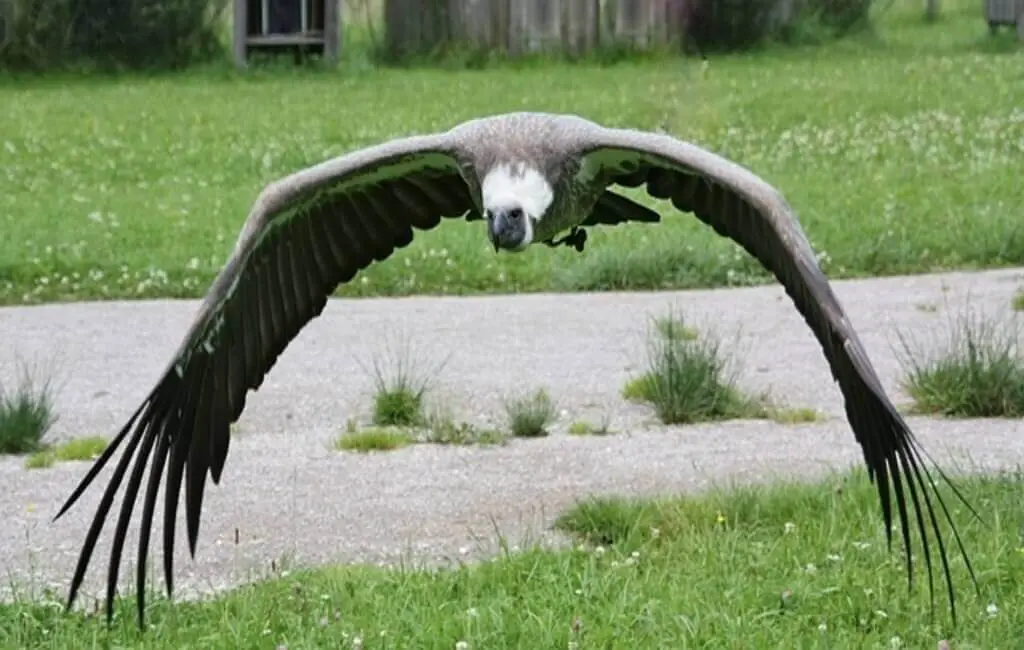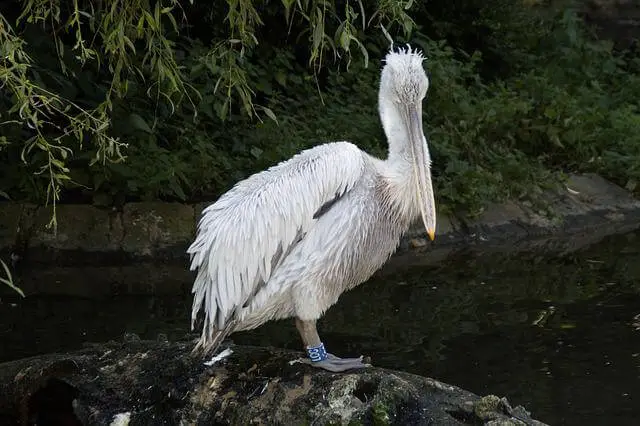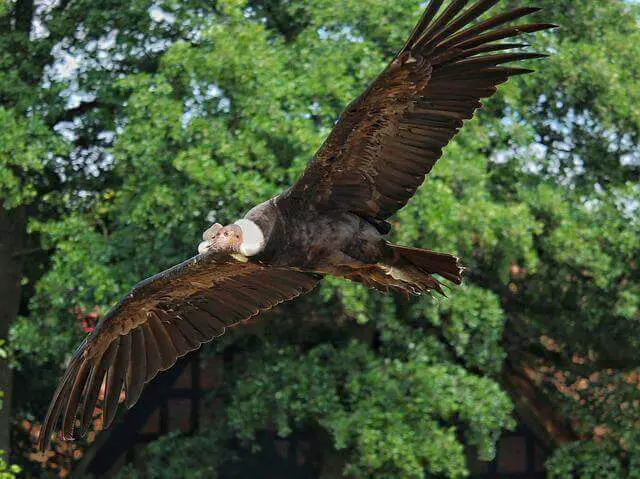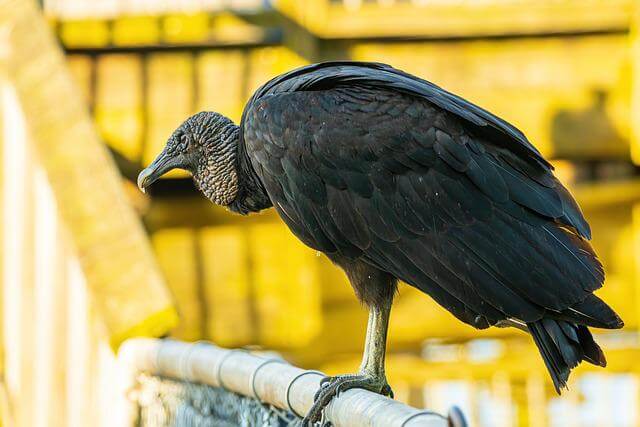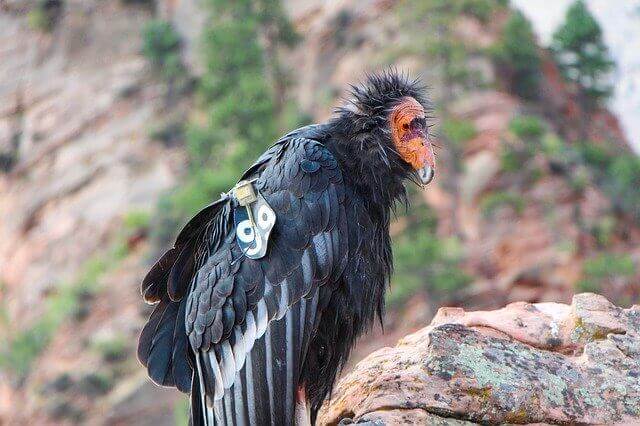In this article, we will introduce you to the 14 largest flying birds in the world, organized by their wingspan. While some of these birds are famous for their elegance, others might be less familiar but equally remarkable in terms of size. Join us as we dive into the list below.
Table of Contents [show]
Largest Flying Birds In The World
Wandering Albatross – 12.1 Feet (3.7 m) Wingspan
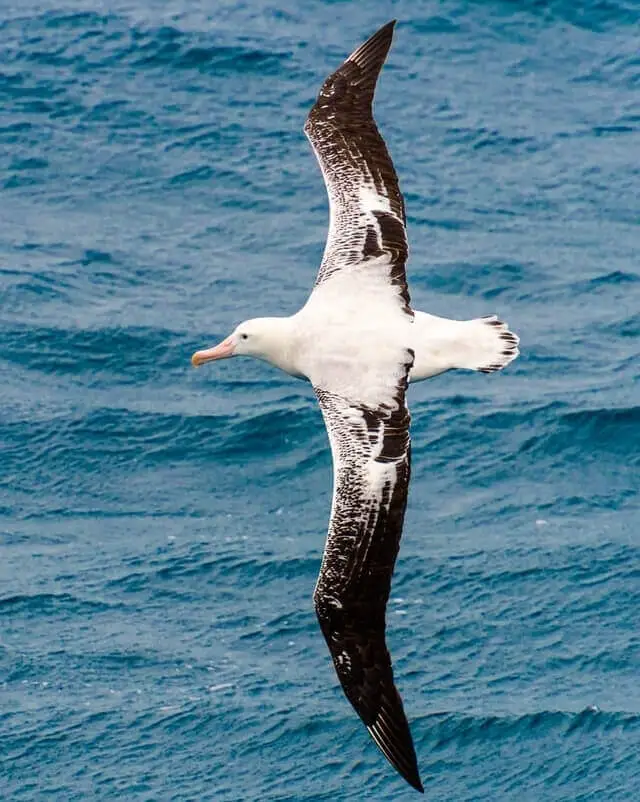
The Wandering Albatross, a magnificent seabird, is renowned for its remarkable characteristics. It boasts the largest wingspan of any living bird, reaching up to 12 feet. With pristine white plumage and a smattering of charcoal-gray on its wings and back, this bird is a true embodiment of elegance. It thrives in the southern oceans, particularly the Southern Ocean, where it effortlessly glides for thousands of miles on its extensive wings.
Its diet mainly consists of seafood, including fish and squid, which it snags from the ocean’s surface. Weighing an average of 8 to 12 kilograms (18 to 26 pounds), the Wandering Albatross is relatively lightweight for its size.
Wandering Albatrosses are known for their incredible flight speed, capable of reaching speeds of up to 78 miles per hour. What truly sets them apart is their remarkable endurance, as they can cover immense distances without rest, making them one of the most enduring avian travelers in the world.
Key Facts about the Wandering Albatross:
| Characteristic | Description |
|---|---|
| Wingspan | Up to 12 feet, the largest wingspan of any living bird |
| Weight | 8 to 12 kilograms (18 to 26 pounds), relatively lightweight |
| Plumage | Pristine white with charcoal-gray on wings and back |
| Habitat | Southern oceans, particularly the Southern Ocean |
| Diet | Primarily seafood, including fish and squid |
| Flight Speed | Capable of reaching speeds of up to 78 miles per hour |
| Endurance | One of the most enduring avian travelers, covering immense distances without rest |
Great White Pelican – 11.8 Feet (3.6 m) Wingspan

The Great White Pelican, known for its impressive 11.8 feet (3.6 meters) wingspan, is a captivating avian species. Despite their substantial size, they are relatively lightweight, with an average weight of around 9 kilograms (20 pounds). Clad in predominantly white plumage, these pelicans exhibit a contrasting mix of black flight feathers on their wings.
They are often found in a variety of wetland habitats, including lakes, rivers, and coastal areas, making them adaptable to different environments. Their diet primarily comprises fish, which they skillfully catch by dipping their massive bills into the water.
Great White Pelicans are renowned for their majestic flight, often gliding gracefully just above the water’s surface. One of their most astonishing features is their ability to cover extensive distances during migration, showcasing their remarkable endurance.
Key Facts about the Great White Pelican:
| Characteristic | Description |
|---|---|
| Wingspan | 11.8 feet (3.6 meters), an impressive wingspan |
| Weight | Approximately 9 kilograms (20 pounds), relatively lightweight |
| Plumage | Predominantly white with contrasting black flight feathers |
| Habitat | Various wetland habitats, including lakes and rivers |
| Diet | Primarily fish, caught by dipping their bills into water |
| Size | Among the largest pelicans, known for their substantial size |
| Flight Style | Graceful and majestic flight, often close to the water’s surface |
| Migration | Able to cover extensive distances during migration, showcasing remarkable endurance |
Southern Royal Albatross – 11.5 Feet (3.5 m) Wingspan

The Southern Royal Albatross is a majestic seabird recognized for its impressive characteristics. It possesses a substantial wingspan, extending up to 11.5 feet, which allows it to soar gracefully through the southern oceans. With a predominantly white plumage, these albatrosses exhibit a dash of charcoal-gray shading on their wings and back.
They thrive in the remote southern seas, particularly the Southern Ocean, where they embark on extensive journeys covering thousands of miles. The diet of the Southern Royal Albatross primarily consists of seafood, including fish and squid, which they skillfully capture from the ocean’s surface.
These birds are known for their remarkable flight speed, reaching up to 78 miles per hour. Their exceptional endurance enables them to traverse vast distances without the need for rest, making them among the world’s most enduring avian travelers.
Key Facts about the Southern Royal Albatross:
| Characteristic | Description |
|---|---|
| Wingspan | Up to 11.5 feet, a significant wingspan for efficient soaring |
| Weight | Typically weighs around 8 to 10 kilograms (18 to 22 pounds) |
| Plumage | Predominantly white with charcoal-gray on wings and back |
| Habitat | Thrives in southern oceans, particularly the Southern Ocean |
| Diet | Mainly feeds on seafood, including fish and squid |
| Flight Speed | Capable of reaching speeds of up to 78 miles per hour |
| Endurance | Remarkable endurance for covering extensive distances without rest |
Dalmatian Pelican – 11.5 Feet (3.5 m) Wingspan
The Dalmatian Pelican, a magnificent waterfowl species, boasts an impressive wingspan measuring up to 11.5 feet. With its characteristic white plumage and striking features, it is among the largest flying birds globally and is known for its captivating appearance.
These pelicans predominantly inhabit various wetlands and water bodies across Europe and Asia. Their diet primarily comprises fish, and they are expert divers, using their long bills to scoop up their aquatic prey.
Typically, Dalmatian Pelicans weigh between 7 to 15 kilograms (15 to 33 pounds). Despite their considerable size, Dalmatian Pelicans are graceful in flight and exhibit remarkable endurance, enabling them to cover substantial distances during their migrations or daily foraging activities.
Key Facts about the Dalmatian Pelican:
| Characteristic | Description |
|---|---|
| Wingspan | Impressive wingspan of up to 11.5 feet |
| Weight | Typically weighs between 7 to 15 kilograms (15 to 33 pounds) |
| Plumage | Predominantly white with a hint of gray on their wings and back |
| Habitat | Inhabit various wetlands, lakes, and rivers in Europe and Asia |
| Diet | Mainly feed on fish, skillfully captured through diving |
| Flight Characteristics | Graceful flight and impressive endurance for long-distance travels |
Tristan Albatross – 11.4 Feet (3.5 m) Wingspan

The Tristan Albatross, with its impressive 11.4-foot wingspan, is a remarkable seabird that graces the remote South Atlantic islands with its presence. These birds exhibit pristine white plumage and are known for their remarkable endurance as they soar through the southern oceans, covering immense distances without rest.
What truly sets them apart is their remarkable ability to travel thousands of miles on their extensive wings. Their diet mainly consists of seafood, including fish and squid, which they skillfully snag from the ocean’s surface.
In addition to their immense wingspan, they can weigh up to 7.5 kg (16.5 lb), making them one of the larger avian species. These characteristics collectively make the Tristan Albatross a remarkable and enduring traveler in the avian world.
Key Facts about the Tristan Albatross:
| Characteristic | Tristan Albatross |
|---|---|
| Wingspan | 11.4 feet (3.5 meters) |
| Weight | Up to 7.5 kg (16.5 lbs) |
| Coloration | White with dark upper wings |
| Range | Southern oceans, Tristan da Cunha |
| Habitat | Breeds on remote islands, forages over open ocean |
| Diet | Fish and squid |
| Flight Speed | Up to 70 mph (112 km/h) |
| Remarkable Endurance | Can cover immense distances without rest |
Amsterdam Albatross – 11.2 Feet (3.4 m) Wingspan

The Amsterdam Albatross is a magnificent seabird known for its impressive characteristics. With a wingspan measuring approximately 11.2 feet (3.4 meters) and a weight that can reach up to 8.2 kg (18 pounds), this bird is truly remarkable. It features white plumage with dark wingtips and back.
These albatrosses primarily inhabit the waters surrounding the Amsterdam and Saint-Paul Islands in the southern Indian Ocean. Their diet consists mainly of seafood, including fish and squid, which they skillfully catch while gliding over the ocean’s surface.
Amsterdam Albatrosses are known for their incredible flight speed, reaching up to 78 miles per hour, and their remarkable endurance, allowing them to cover vast distances without rest.
Key Facts about the Amsterdam Albatross:
| Characteristic | Amsterdam Albatross |
|---|---|
| Wingspan | 11.2 feet (3.4 meters) |
| Weight | Up to 8.2 kg (18 lbs) |
| Coloration | White with dark wingtips and back |
| Range | Amsterdam and Saint-Paul Islands, southern Indian Ocean |
| Habitat | Pelagic, open ocean, islands |
| Diet | Fish and squid |
| Flight Speed | Up to 78 mph (125 km/h) |
| Remarkable Endurance | Can cover vast distances without rest |
Antipodean Albatross – 10.8 Feet (3.3 m) Wingspan

The Antipodean Albatross is a remarkable seabird known for its impressive characteristics. It boasts a wingspan of approximately 10.8 feet (3.3 meters) and can weigh up to 8.5 kilograms (18.7 pounds). This albatross displays striking white plumage with dark wingtips and back.
They primarily inhabit the waters around the Antipodes Islands in the southern Pacific Ocean. Their diet mainly consists of seafood, including fish and squid, which they skillfully capture while soaring above the ocean’s surface.
Antipodean Albatrosses are recognized for their remarkable flight speed, capable of reaching up to 78 miles per hour, and their extraordinary endurance, allowing them to cover vast distances without rest.
Key Facts about the Antipodean Albatross:
| Characteristic | Antipodean Albatross |
|---|---|
| Wingspan | 10.8 feet (3.3 meters) |
| Weight | Up to 8.5 kg (18.7 lbs) |
| Coloration | White with dark wingtips and back |
| Range | Antipodes Islands, southern Pacific Ocean |
| Habitat | Pelagic, open ocean, islands |
| Diet | Fish and squid |
| Flight Speed | Up to 78 mph (125 km/h) |
| Remarkable Endurance | Can cover vast distances without rest |
Andean Condor – 10.8 Feet (3.3 m) Wingspan
The Andean Condor is indeed a magnificent bird of prey, boasting a wingspan that stretches approximately 10.8 feet (3.3 meters). This grandeur is matched by its substantial weight, which can reach up to 12 kilograms (26 pounds).
Its striking appearance, characterized by black plumage with a pristine white collar and distinct white patches on its wings, makes it an iconic figure in the high mountain ranges and open skies of South America, especially the Andes Mountains.
An obligate scavenger, the Andean Condor primarily feeds on carrion, showcasing its role as a vital part of the ecosystem’s cleanup crew. But what truly sets it apart is its impressive gliding ability, allowing it to effortlessly navigate the high altitudes where it resides.
Key Facts about the Andean Condor:
| Characteristic | Andean Condor |
|---|---|
| Wingspan | 10.8 feet (3.3 meters) |
| Weight | Up to 12 kg (26 lbs) |
| Coloration | Black with white collar and wing patches |
| Range | Andes Mountains, South America |
| Habitat | High mountain ranges, open skies |
| Diet | Carrion |
| Flight Speed | Remarkable gliding abilities |
| Remarkable Endurance | Known for soaring at high altitudes |
Northern Royal Albatross – 10.5 Feet (3.2 m) Wingspan

The Northern Royal Albatross is a remarkable seabird with an impressive wingspan of approximately 10.5 feet (3.2 meters). These majestic birds can weigh up to 8.2 kilograms or around 18 pounds, making them a symbol of grace and endurance in the world of avian giants. Their plumage is predominantly white, providing a striking contrast to the deep blue oceans they call home.
These albatrosses primarily reside in the sub-Antarctic waters and the Southern Ocean. They are known for their remarkable endurance, often soaring through the skies for thousands of miles without a pause.
With impressive flight speeds, these birds can cover immense distances while searching for food, which primarily consists of seafood, including fish and squid. Their range includes sub-Antarctic regions, making them a fascinating part of the Southern Ocean’s ecosystem.
Key Facts about the Northern Royal Albatross:
| Characteristic | Measurement |
|---|---|
| Wingspan | Approximately 10.5 feet (3.2 m) |
| Weight | Up to 8.2 kg (18 pounds) |
| Plumage | Predominantly white |
| Habitat | Sub-Antarctic waters, Southern Ocean |
| Flight Speed | Remarkable endurance (speeds of up to 127 km/h or 79 mph) |
| Flight Range | Thousands of miles with remarkable endurance |
Marabou Stork – 10.5 Feet (3.2 m) Wingspan
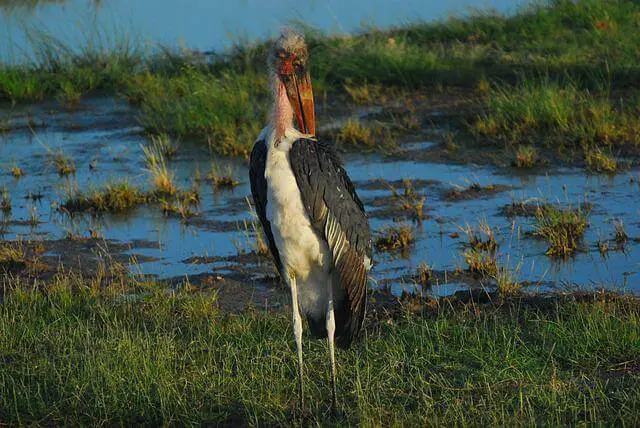
The Marabou Stork is a captivating avian species with a distinctive presence, featuring an impressive 10.5-foot wingspan (3.2 meters) and a substantial weight that can reach up to 9 kilograms or 20 pounds. These storks are predominantly adorned with white plumage, a striking contrast to their featherless head and neck, making them easily recognizable.
They are known to inhabit a diverse range of wetland habitats across sub-Saharan Africa, where they display their versatile diet that includes scavenging for carrion, catching fish, and hunting various aquatic creatures.
While they may not be the fastest in terms of flight speed, their remarkable ability to adapt to different environments and their enduring flights make them a subject of intrigue in ornithology.
Key Facts about the Marabou Stork:
| Characteristic | Marabou Stork |
|---|---|
| Wingspan | 10.5 feet (3.2 meters) |
| Weight | Up to 9 kilograms or 20 pounds |
| Plumage | Predominantly white with featherless head and neck |
| Habitat | Diverse wetland habitats in sub-Saharan Africa |
| Diet | Scavengers of carrion, fish, and aquatic creatures |
| Flight Speed | Not known for speed, but for endurance |
Cinereous Vulture – 10.2 Feet (3.1 m) Wingspan
The Cinereous Vulture, a magnificent bird of prey, possesses an impressive 10.2-foot wingspan (3.1 meters) and can weigh up to 14 kilograms (31 pounds). Draped in dark plumage that serves as a perfect camouflage in their habitats, this vulture’s broad wings allow it to rule the open skies as it soars above its extensive range.
These vultures are a common sight in a variety of habitats across Europe and Asia, from the rugged mountain ranges to vast grasslands. Their diet primarily consists of carrion, showcasing their vital role as nature’s clean-up crew.
While they may not be the fastest birds in the sky, their remarkable ability to cover substantial distances while effortlessly gliding makes them a symbol of both power and grace.
Key Facts about the Cinereous Vulture:
| Characteristic | Cinereous Vulture |
|---|---|
| Wingspan | 10.2 feet (3.1 meters) |
| Weight | Up to 14 kilograms (31 pounds) |
| Plumage | Dark plumage, suited for soaring |
| Habitat | Various habitats in Europe and Asia |
| Diet | Carrion eaters, critical for ecosystem health |
| Flight Speed | Not known for speed, but for endurance and soaring |
Himalayan Griffon Vulture – 10.2 Feet (3.1 m) Wingspan
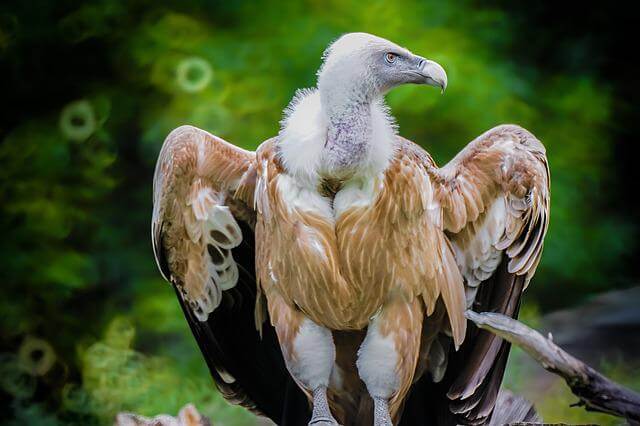
The Himalayan Griffon Vulture is a magnificent bird of prey with an impressive 10.2-foot wingspan (3.1 meters). These majestic birds can weigh up to 12 kilograms (26.5 pounds), making them one of the largest and heaviest Old World vultures. Their plumage is predominantly brown, and they are known for their distinctive white neck ruff.
These vultures inhabit the rugged terrains and open skies of the Himalayas and surrounding regions. With their exceptional soaring abilities and keen eyesight, Himalayan Griffon Vultures play a crucial role in maintaining the ecological balance by scavenging carrion from the vast landscapes they call home.
While not known for their speed, these vultures are remarkable for their endurance and efficiency in utilizing air currents for effortless flight.
Key Facts about the Himalayan Griffon Vulture:
| Characteristic | Himalayan Griffon Vulture |
|---|---|
| Wingspan | 10.2 feet (3.1 meters) |
| Weight | Up to 12 kilograms (26.5 pounds) |
| Plumage | Predominantly brown with a white neck ruff |
| Habitat | Himalayan and surrounding regions |
| Diet | Carrion scavengers, vital for the ecosystem |
| Flight Speed | Known for endurance and efficient soaring |
Trumpeter Swan – 10.2 Feet (3.1 m) Wingspan
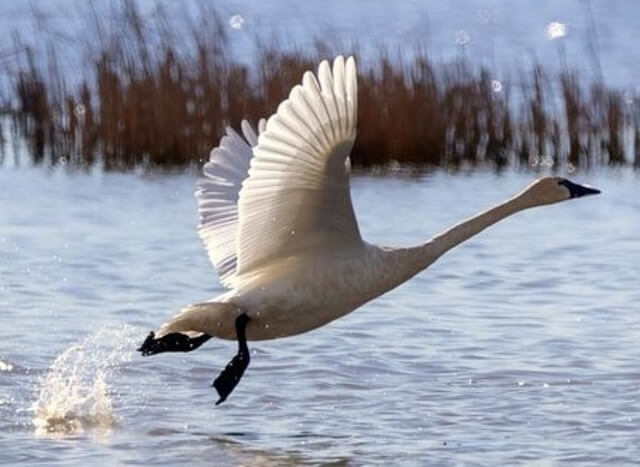
The largest waterfowl in North America the Trumpeter Swan, with its impressive 10.2-foot wingspan (3.1 meters), is a sight to behold in North American wetlands. These regal birds can attain weights of up to 17.2 kilograms (38 pounds), making them the heaviest waterfowl globally.
They are renowned for their snow-white plumage and distinctive black beaks. Trumpeter Swans inhabit various wetland habitats, including lakes, ponds, and marshes, where they gracefully glide across the water’s surface.
Their herbivorous diet primarily consists of aquatic plants, which they forage for underwater. While not known for their speed, these swans exhibit remarkable endurance during their long migratory journeys and are considered a symbol of grace in the avian world.
Key Facts about the Trumpeter Swan:
| Characteristic | Trumpeter Swan |
|---|---|
| Wingspan | 10.2 feet (3.1 meters) |
| Weight | Up to 17.2 kilograms (38 pounds) |
| Plumage | Snow-white with a distinctive black beak |
| Habitat | North American wetlands |
| Diet | Herbivorous, feeding on aquatic plants |
| Flight Speed | Known for endurance during migration |
California Condor – 10 Feet (3.05 m) Wingspan
The California Condor, a critically endangered species, is a magnificent bird with a wingspan measuring approximately 10 feet (3.05 meters). These colossal birds can weigh up to 14.1 kilograms (31 pounds), making them one of the heaviest flying birds in North America.
Recognizable by their stark black plumage, featherless heads, and distinctive white markings, California Condors are native to the western parts of the United States. These condors are nature’s clean-up crew, primarily feeding on carrion, and they play a vital role in maintaining the balance of their ecosystems.
While they might not be the fastest flyers, California Condors are remarkable for their ability to cover extensive distances in search of food and are a testament to the importance of conservation efforts.
Key Facts about the California Condor:
| Characteristic | California Condor |
|---|---|
| Wingspan | 10 feet (3.05 meters) |
| Weight | Up to 14.1 kilograms (31 pounds) |
| Plumage | Predominantly black with white markings |
| Habitat | Western parts of the United States |
| Diet | Vital carrion scavengers in their ecosystems |
| Flight Speed | Not the fastest, but capable of covering distance |

